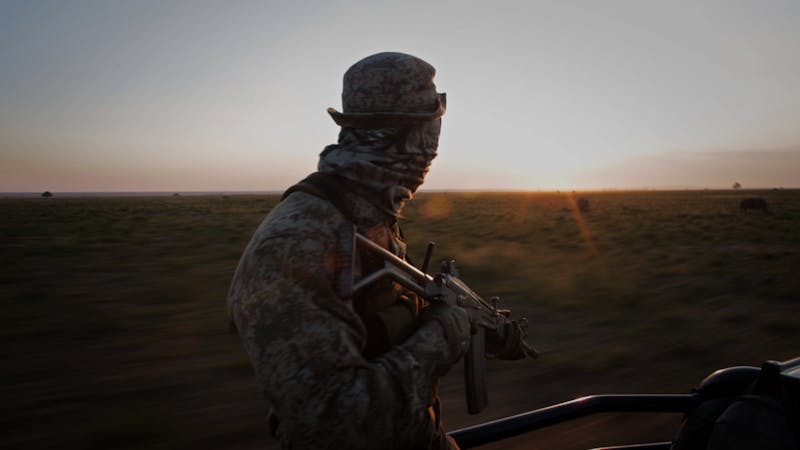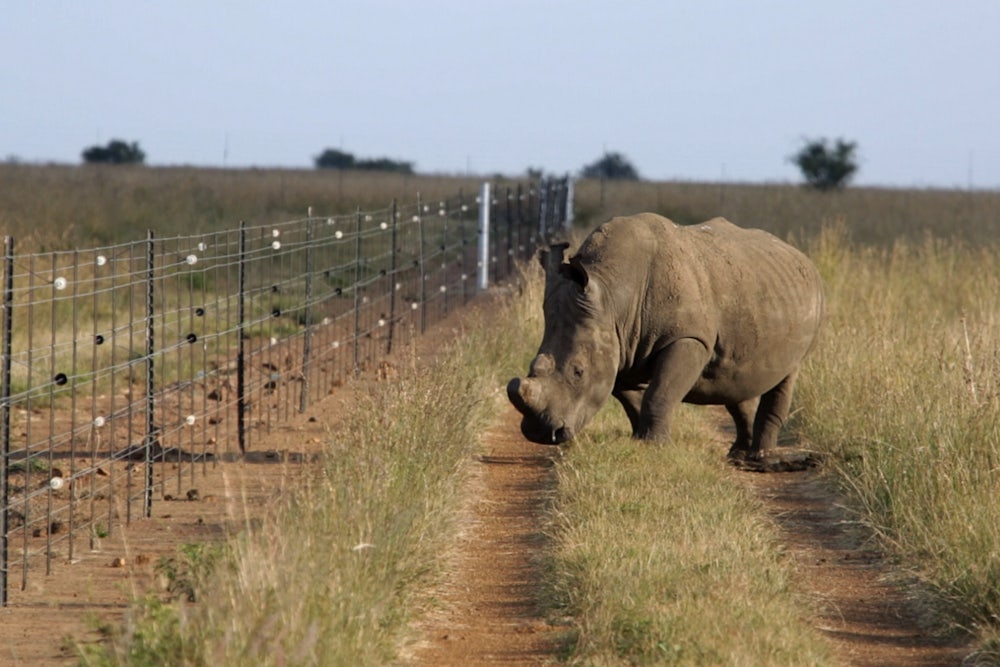There is an elephant in the room. He or she (I can’t tell these things) is surrounded by an opera house-style velvet rope and frozen in majestic attitude. The elephant is on display at the Safari Club International Convention in Las Vegas, the largest such gathering on earth. There are many human babies at this convention, and every type of animal. There is a coffee table made out of glass and a stuffed crocodile. A woman chirps to the camera that “Crocodiles are really mean, so I don’t feel bad about killing them.”
The Vegas convention is just one location in Trophy, a new documentary from directors Shaul Schwarz and Christina Clusiau about the business of Americans hunting big game in southern Africa. Trophy also takes us to the Caprivi Strip in Namibia, where American hunter Philip Glass (no, not the composer) will stalk an elephant on his quest to bag all of what big game hunters call the “Big Five”—buffalo, leopard, elephant, lion, rhino. We go to the Zambezi Valley in Zimbabwe, where a lion is eating a local woman’s cows, but anti-poaching laws won’t let her shoot it. We visit the Buffalo Dream Ranch in South Africa, where John Hume is breeding the largest private collection of rhinos on earth: he sells their horn, he says, to keep the species alive. But the heart of this documentary lies in the US and Canada, home of 70 percent of the wealthy hunters who pursue Africa’s big game on pleasure trips to enclosed ranches and resorts where their kills are guaranteed.
Trophy is about a single, multifaceted ethical dilemma: Should African farms breed animals for Americans to kill? An American ecologist named Craig Packer explains one angle. In recent decades, property owners have registered a profit motive in changing private land from livestock use to game ranching. Because Americans want to hunt trophy species like Sable Antelope or the animals of the big five, ranchers breed more of them. So, now, there are probably more predators in South Africa than there were a hundred years ago. Ironically, the demand for animals to kill keeps the species alive.
John Hume doesn’t allow his rhino to be hunted, but he harvests their horns every two years with an electric saw in a process that looks horrific but which he compares to a human’s wisdom tooth removal. Taking the horns makes the rhino less vulnerable to poaching, he claims, while selling the horn allows him to make enough money to continue breeding this endangered species. Trophy follows Hume as he challenges the South African government to lift their moratorium on the sale of rhino horn, which had been causing illegal poaching to skyrocket. The hunting industry is full of paradoxes like these. Legislation designed to curb poaching in fact inflates it massively. “If you’re anti legal trade,” Hume says to a friend, “You’re pro illegal trade.”
The argument used by ranchers who breed big game for hunting resembles Hume’s justification for selling rhino horn. Hunting an elephant can cost something like $50,000. That money all flows back into breeding and caring for elephants, hunters argue. This is called the “if it pays, it stays” principle.
Poaching damages that business and reduces the population of animals, so it must be curbed. It is ironic, an anti-poaching professional concedes in Trophy: “We are fighting to save something so that somebody else can kill it.” Meanwhile, lions and elephants can do serious harm to the local population. That woman whose cows have been savaged by a lion has taken to keeping her last cow inside. The lion will follow the cow eventually, and “it’s just a matter of time before somebody gets eaten,” the anti-poaching officer says.
And so we have a rich tangle of ethics surrounding preservation. Hunting means more elephants and lions, but only for the purposes of killing elephants and lions. Only rich tourists are allowed to kill those elephants and lions. Some money will trickle in to the region, and local people are allowed to chop up elephant carcasses, for example, for meat. But is the net result really a positive one for the population? And which population—the animals, the Zimbabweans and South Africans and Namibians, the Americans and Canadians—is really pulling the strings here?

Activists like Adam Roberts of the Born Free organization argue in Trophy that the conservation-and-local-economy argument is an old and tired alibi for the simple, Rooseveltian lust for killing. The money doesn’t flow equitably back into the communities that surround the breeding farms of Southern Africa, the activists argue, especially in regions that suffer from systemic corruption.
Meanwhile, it is not ethical, anti-hunting activists say, to hunt animals like fish in a barrel. That this opinion is a popular one in the West is attested by the enormous celebrity enjoyed by Cecil the Lion after his death at the hands of a Minnesotan Dentist. After that animal’s death, Americans who are not inclined toward big game hunting were forced to consider why some people are. Are the wealthy men (they are nearly all men) who shoot animals in Africa investing in some fantasy of a powerful, self-sufficient ancient hunter? Is big game hunting in Africa, a pursuit enjoyed largely by white people, a remnant of oppressive colonial structures? Is it simple sadism ? In Trophy we follow the sweet-faced Philip Glass on his hunts. He is furious with the bureaucrats who claim it is “a privilege, not a right” to bring back these animals as trophies to the US. He believes that God gave man dominion over the animals. He also says that “Anybody who believes in evolution is a complete fool.”
Glass provides the most horror in this documentary. We see him shoot and kill an elephant, shooting it while it’s running away. The animal makes an extraordinary noise as it lies in the ground, like a growl mixed with a howl that turns into mewling. We see its eye so close up that its eyelashes are visible. The hunter and his guides wash the blood from its flank with water so that it will look better in the trophy photograph. Then we see the dead elephant from an aerial shot, lying flush against the ground with one leg crooked as if it is still running.
The elephant death is extraordinary footage, but Glass’s climactic kill is an adult male lion. Glass weeps over its body. He pets its corpse like it is alive. He marvels at its paws and claws, proclaiming it “absolutely magnificent” through tears. “This is my trophy and there’s not any bureaucrat that can take it away from me,” Glass says, fluffing up the lion’s mane like a hairdresser. He cries and speaks about his dead father, who would be proud of him in this moment.
Trophy is an extraordinary accomplishment, for its nuanced presentation of a very tangled issue but more importantly for its gorgeous, wrenching footage of what happens when an American pays to kill an African animal. There are no simple solutions to the ethical and practical problems surrounding species preservation and the economy of southern African nations. But the act of killing is simple, for men like Philip Glass. His right of dominion over the animals is God-given, and in his enactment of that right over the most powerful of animals, he fulfills a tradition and an identity handed down to him from his father. Among the many tensions of Trophy, that dynamic—between complicated and simple, between life and death—animates and unsettles.
